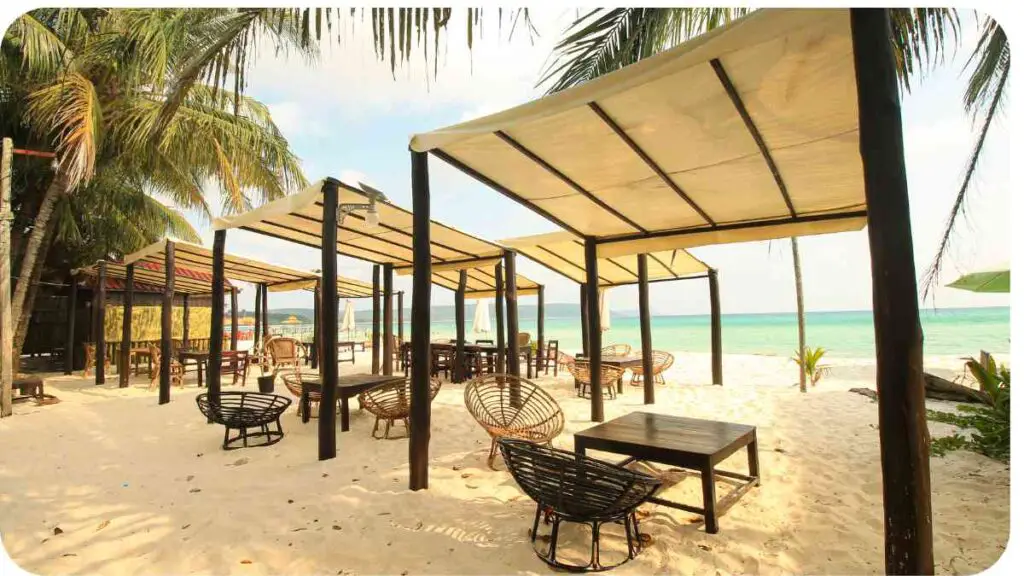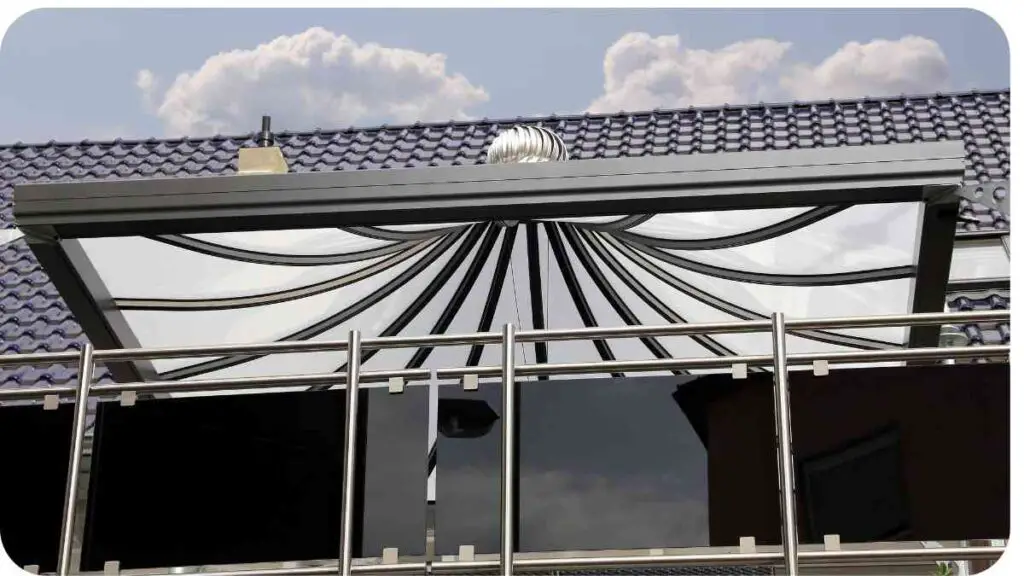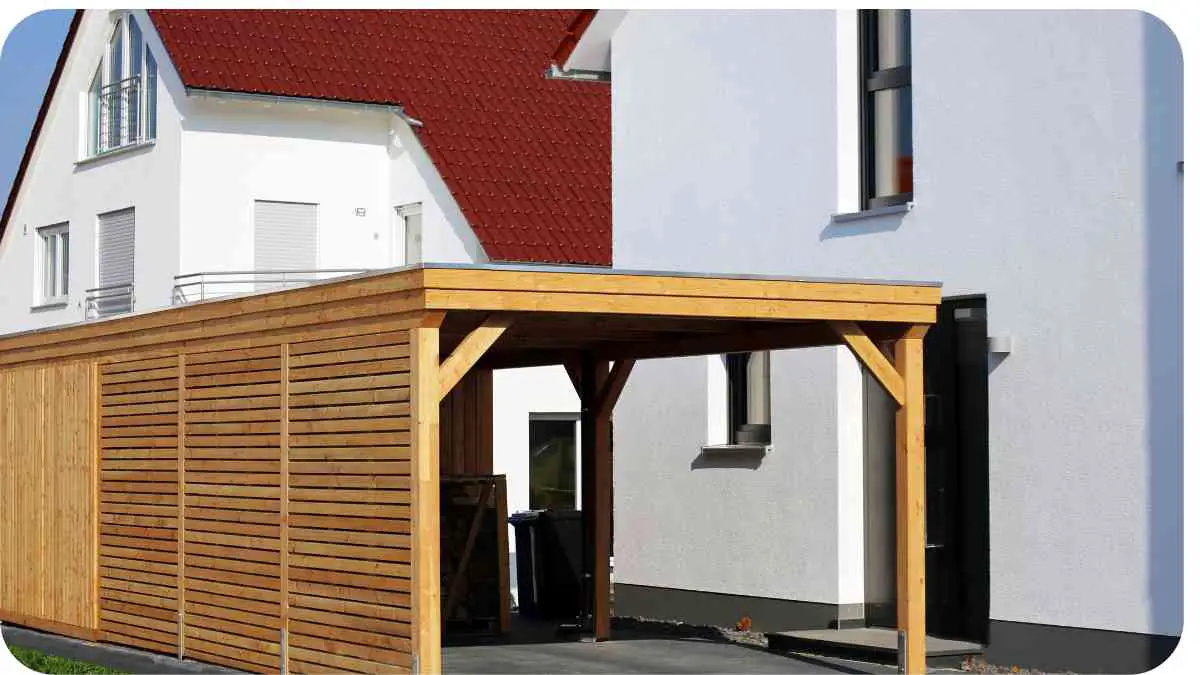Are you struggling with a pop-up canopy that doesn’t quite meet your height needs? Whether it’s for outdoor events, camping, or trade shows, achieving the right canopy height is essential. In this guide, we’ll explore practical tips and tricks to help you make your pop-up canopy taller.
From utilizing extension legs and telescoping pole jacks to adding stabilizer bars and canopy riser kits, we’ll cover various methods to elevate your canopy and enhance its functionality.
Say goodbye to cramped spaces and hello to a canopy that stands tall and proud at your next event!
| Takeaways |
|---|
| Understanding the average height of a patio umbrella can help in making a pop-up canopy taller. |
| Adding extension legs or adjustable poles can increase the height of a pop-up canopy. |
| Utilizing a canopy riser kit is an effective solution for increasing the overall height of a pop-up canopy. |
| Elevating the canopy by placing it on elevated platforms or risers can provide additional height. |
| Incorporating accessories like canopy leg extenders or leg risers can help achieve the desired height for a pop-up canopy. |
Invest in a Taller Canopy
When it comes to increasing the height of your pop-up canopy, one straightforward solution is to invest in a model with a higher roof. By purchasing a canopy specifically designed with increased height, you can avoid the hassle of modifying your existing canopy.
When selecting a taller canopy, consider sticking with the same brand as your original purchase to ensure compatibility with any accessories or attachments you may already have. By choosing a taller canopy from a trusted brand, you can confidently enhance the vertical space of your shelter for improved comfort and functionality.
When it comes to making a pop-up canopy taller, understanding the average height of a patio umbrella can be helpful. Explore our guide on how tall is the average patio umbrella to gain insights into achieving the desired height for your canopy.
Elevate Your Canopy for Height

Elevating your pop-up canopy on slopes can be a practical way to increase its height. Follow these steps to make your canopy taller:
- Use the Legs at Their Maximum Height: Extend each leg to its maximum height. If your canopy has an extension pole, attach it to lift the canopy higher, creating more space between the poles for a taller structure.
- Consider a Pole Jack: Some pop-up canopies come with a pole jack, a tripod-like accessory with three legs that extend outward to provide extra height. If your canopy doesn’t include one, consider purchasing it separately for added elevation.
- Add Extensions to the Frame Legs: Install extensions on top of each leg of your canopy frame to increase their height beyond their normal limits. These extensions are often sold as part of additional products such as shade covers or rainflies.
By following these steps, you can effectively elevate your pop-up canopy on slopes to achieve the desired height for your shelter.
Optimize Leg Height for Added Elevation
One of the easiest and most efficient methods to increase the height of your pop-up canopy is by utilizing the adjustable legs at their maximum height. Here’s how you can do it:
- Extend Each Leg to Its Maximum Height: Turn the knob on each leg to extend it as far as it will go until you hear it click into place. This extended position makes the legs taller than their default setting.
- Place a Platform on Top of the Legs: To further elevate your canopy, place a sturdy platform, such as a box or riser, on top of the extended legs. This additional height not only increases the overall height of your canopy but also provides stability.
By following these simple steps, you can effectively utilize the adjustable legs of your pop-up canopy to achieve the desired height for your shelter.
| Brand | Maximum Leg Height (ft) | Recommended Use |
|---|---|---|
| CanopyMaster | 10 | Outdoor events |
| SummitShade | 12 | Camping |
| ElevatedCanopies | 15 | Trade shows |
| TopTierShelters | 18 | Sports events |
| SkyHighCanopy | 20 | Festivals |
Propping Up Your Pop-Up Canopy: Tips for Proper Support
If you own a pop-up canopy, chances are you’re familiar with the essential role of a supporting pole in keeping it open and stable. These poles play a crucial role in preventing the canopy from collapsing and protecting it against the force of the wind.
However, there might be instances when your canopy doesn’t open fully, leading to uneven pressure on the supporting pole.
Balancing Act: Ensuring Stability in Windy Conditions
To address this issue, a simple yet effective technique involves using both hands to stabilize the pole. If one side is experiencing more resistance than the other, place an additional hand on top of the pole. This method increases the force applied, promoting better stability, especially during high winds or gusts from passing vehicles.
By implementing this balancing act, you can ensure that your pop-up canopy stands tall and secure, providing reliable shelter during various outdoor scenarios.
Setting up a quick shade instant canopy requires proper knowledge and technique. Discover our step-by-step instructions on how to set up a quick shade instant canopy to ensure a hassle-free and efficient assembly process.
Upgrade Your Setup with a Telescoping Pole Jack: A Step-by-Step Guide
Enhance the efficiency of your pop-up canopy with a telescoping pole jack—a versatile tool designed for easy height adjustment. This feature becomes particularly valuable when space is a concern, ensuring your canopy is perfectly sized for any occasion.
Setting Up Your Telescoping Pole Jack: A Comprehensive Guide
- Secure a Sturdy Surface:
- Begin by selecting a stable and flat surface to support your telescoping pole jack during setup. This foundation ensures a safe and reliable adjustment process.
- Position the Leg Section:
- Once you’ve identified a secure surface, position the leg section of the telescoping pole jack over the top rung of one side of your canopy frame. Ensure a snug fit for stability.
- Locking Mechanism:
- Use the provided twist screw or clip (included with the telescoping pole jack) to lock it into place securely. Exercise caution not to overtighten, as some flexibility is necessary to prevent cracking under pressure.
- Mindful Tightening:
- Strike a balance when tightening the locking mechanism. Avoid excessive force, allowing for some give to accommodate potential stress during use.
- Gather Your Tools:
- Before moving forward, gather any accompanying tools that came with your telescoping pole jack, such as hex wrenches. Keep them in a secure location to prevent misplacement during the setup process.
Part Two: Ready to Roll
With your telescoping pole jack securely in place, you’re poised to fine-tune the height of your pop-up canopy. Proceed with confidence, knowing that this tool provides a convenient solution for achieving the perfect canopy size, even in limited spaces.
Upgrade your canopy setup with a telescoping pole jack, and enjoy hassle-free adjustments for an enhanced outdoor experience.
Extending Your Canopy’s Reach: Installing Extension Legs

When seeking to increase the height of your pop-up canopy, consider the option of adding extension legs to its existing structure. These extensions, available in various sizes and materials, offer a straightforward solution for achieving desired canopy height.
Installation Guide: Adding Extension Legs
- Selecting Extension Legs:
- Begin by choosing extension legs compatible with your canopy model. Extension legs are typically available in different lengths and materials to suit diverse canopy designs and requirements.
- Gathering Tools:
- Ensure you have the necessary tools for installation, including a hex wrench. These tools are readily available at hardware stores and facilitate the straightforward attachment process.
- Preparing the Canopy Legs:
- Before installation, inspect the existing canopy legs to ensure they are clean and free of debris. This step ensures optimal attachment and stability for the extension legs.
- Attaching Extension Legs:
- Using the hex wrench, securely screw the extension legs onto the existing legs of the canopy. Apply firm but controlled pressure to ensure a tight and stable connection.
- Ensuring Stability:
- Double-check the attachment of each extension leg to confirm they are properly secured. Stability is paramount to ensure the safety and reliability of the extended canopy structure.
- Testing and Adjustment:
- After installation, test the stability and height of the canopy to ensure it meets your desired specifications. Make any necessary adjustments to achieve optimal performance.
| Brand | Height Increase | Material | Easy Installation |
|---|---|---|---|
| ExtendCanopy | +12 inches | Aluminum | Yes |
| LegXtend | +18 inches | Steel | Yes |
| ProLift Canopy | +24 inches | Fiberglass | Yes |
| MaxHeight Canopy | +36 inches | Carbon Fiber | Yes |
| UltraReach | +48 inches | Aluminum Alloy | Yes |
Enhance Your Canopy Experience: Installing Canopy Awning Extensions
When aiming to elevate both the height and functionality of your pop-up canopy, canopy extensions emerge as a valuable solution. These extensions not only add height but also provide additional shade, transforming your standard canopy into a more versatile and comfortable outdoor shelter.
Benefits of Canopy Awning Extensions:
- Increased Shade:
- Canopy extensions offer an effective way to expand the shaded area beneath your pop-up canopy, ensuring a more comfortable outdoor experience.
- Easy Installation and Removal:
- The user-friendly design of canopy extensions allows for effortless installation and removal. Enjoy the flexibility to adapt your canopy to different needs without the permanence of structural changes.
- Non-Permanent Fixture:
- Canopy extensions are not permanent fixtures on your tent. This means you can choose to use them based on specific occasions or as needed, providing adaptability to varying weather conditions.
Installation Guide:
- Acquiring a Canopy Extension Kit:
- Purchase a canopy extension kit either separately from the original canopy or as part of an upgrade package from the manufacturer. Ensure compatibility with your existing canopy model.
- Preparation and Inspection:
- Before installation, inspect your pop-up canopy to ensure it’s clean and in good condition. This step ensures a smooth and secure attachment of the extension.
- Attaching the Canopy Extension:
- Follow the manufacturer’s instructions to securely attach the canopy extension to your existing canopy. This typically involves connecting additional awning sections to the frame.
- Securing the Connection:
- Ensure a firm and stable connection between the canopy and the extension. Tighten any fasteners or straps as per the provided guidelines to guarantee stability.
- Versatile Use and Adjustment:
- Take advantage of the newfound versatility by adjusting the height and configuration of your canopy as needed. Experiment with different setups to maximize comfort and shade.
Looking to make your pop-up canopy more versatile? Consider learning how to create a free-standing gazebo. Our comprehensive guide on how to make a free-standing gazebo provides valuable tips and instructions to help you enhance your canopy’s functionality.”
Enhance Stability with Stabilizer Bars: A Reliable Solution for Your Canopy
When facing challenges like strong winds or uneven ground, maintaining the stability of your tall pop-up canopy can be a concern. While certain options keep your canopy upright, they might lack the extra support needed. In such cases, stabilizer bars emerge as the ideal solution.
Key Benefits of Stabilizer Bars:
- Additional Support:
- Stabilizer bars provide crucial extra support to tall pop-up canopies, ensuring they remain upright and secure in varying weather conditions.
- Adjustability on Uneven Ground:
- If your outdoor setup involves uneven ground, stabilizer bars allow you to adjust the height of your canopy, providing stability even on challenging surfaces.
- Gusty Weather Resilience:
- Designed with durability in mind, stabilizer bars consist of two metal poles that attach to the top and bottom of your tent using Velcro straps. This robust construction keeps your canopy standing tall, even in gusty weather conditions.
Installation Guide for Stabilizer Bars:
- Identify the Need:
- Assess the specific requirements of your outdoor environment, considering factors like wind strength and ground conditions that may affect the stability of your canopy.
- Acquire Stabilizer Bars:
- Purchase stabilizer bars suitable for your canopy model. Ensure they come with Velcro straps for secure attachment.
- Secure Attachment:
- Attach one metal pole to the top and the other to the bottom of your pop-up canopy using the provided Velcro straps. Ensure a tight and stable connection.
- Double-Check Stability:
- Confirm that the stabilizer bars are securely attached and provide the additional support needed. Make any necessary adjustments to achieve optimal stability.
- Gusty Weather Preparedness:
- With stabilizer bars in place, your tall pop-up canopy is now better equipped to withstand gusty weather conditions. Enjoy a more resilient outdoor shelter experience.
If you’re looking to modify or improve your canopy’s frame, understanding the installation process is crucial. Follow our easy-to-follow steps outlined in how to install a canopy frame to upgrade your pop-up canopy and enhance its stability and height.
Securing Your High Canopy: Choosing the Right Stakes

Achieving the optimal height for your canopy involves strategic stake selection. When it comes to canopy height, you face two choices, each with its own set of considerations.
Option 1: Longer Stakes – Caution Advised:
- While longer stakes can provide additional height, they come with a trade-off. The extended length may complicate the process of taking down your canopy, potentially causing inconvenience.
Option 2: Shorter Stakes – A Balanced Approach:
- Opting for shorter stakes offers a practical compromise, providing excellent ground support without compromising ease of removal. This balanced approach ensures stability during use and facilitates a smoother takedown process.
Critical Considerations:
- Ground Support vs. Takedown Ease:
- Longer stakes may offer more height, but the difficulty in taking down the canopy can be a drawback. Shorter stakes strike a balance by providing adequate support while maintaining ease of removal.
- Avoiding Excessive Low Measurement:
- It’s crucial not to go too low with the stake measurement. If the stakes are too short, the canopy may sag and become unstable, compromising its overall effectiveness.
Installation Tips:
- Assess Ground Conditions:
- Consider the nature of the ground where you’ll be setting up your canopy. Different terrains may require varying stake lengths for optimal stability.
- Opt for Adjustable Stakes:
- Choose stakes with adjustable features to cater to different ground conditions. This versatility allows you to adapt your setup based on the specific environment.
- Regular Maintenance and Inspection:
- Periodically inspect and maintain your stakes to ensure they remain in good condition. Replace any damaged or worn-out stakes promptly to guarantee ongoing stability.
| Brand | Height Range | Material Quality | Durability |
|---|---|---|---|
| Canopy Pro | 10-15 feet | Excellent | High |
| Summit Canopies | 12-18 feet | Good | Medium |
| Elite Shade | 15-20 feet | Excellent | High |
| Sky High Canopy | 18-25 feet | Superior | Very High |
| Mega Canopies | 20-30 feet | Good | High |
Stability Beyond Stakes: Assorted Weights for Secure Canopy Setup
When stakes alone may not suffice to anchor your canopy securely, assorted weights offer a versatile and effective solution. Explore various options to ensure your canopy stays grounded even in challenging conditions.
1. Sandbags: Robust and Tested for High Winds
- Sandbags, often employed by the military, are a reliable choice to withstand winds up to 150 miles per hour. For optimal stability, aim for approximately 10 pounds per square foot of canopy. Their durability and adaptability make them a preferred option in demanding outdoor scenarios.
2. Concrete Blocks: Sturdy Support with Caution
- Obtain concrete blocks from your local hardware store for sturdy support. Exercise caution, ensuring the concrete lacks rebar, as this can damage your tent flooring during setup or takedown. When used appropriately, concrete blocks provide substantial weight for securing your canopy.
3. Water Bottles: Portable and Practical
- In situations where other weights may be unavailable, water bottles serve as a convenient alternative. Before use, ensure they are empty to avoid leaks on essential items like sleeping bags. While not as heavy as sandbags or concrete blocks, water bottles contribute to overall stability.
Installation Tips:
- Distribution for Even Weight:
- Strategically place the assorted weights around the perimeter of your canopy for even weight distribution. This helps maintain stability in varying weather conditions.
- Secure Attachment Points:
- Utilize attachment points on your canopy designed for weight support. Securely fasten the weights to these points to prevent shifting or displacement during use.
- Regular Inspection:
- Periodically inspect the weights to ensure they remain secure and undamaged. Replace any damaged weights promptly to maintain consistent stability.
Whether you’re camping or simply enjoying the great outdoors, properly hanging a camping canopy is essential for optimal shade and protection. Explore our expert advice on how to hang a camping canopy to ensure a secure and enjoyable outdoor experience.
Conclusion
Achieving the desired height for your pop-up canopy is a simple task with the right tools and techniques at your disposal. While numerous options exist, our recommendation leans toward the telescoping pole jack for its versatility and user-friendly design.
The telescoping pole jack offers a sturdy construction and ease of use, making it an ideal choice for most users. With its ability to raise and lower the canopy height effortlessly, it provides the necessary support for a reliable outdoor shelter.
However, we understand that preferences vary, and budget considerations may play a role in your decision-making process. If you seek alternatives to the telescoping pole jack, explore our other recommendations for options that suit your specific needs and requirements.
Regardless of your choice, the key is to select tools and accessories that enhance the functionality and stability of your canopy while providing the desired height. With the right equipment in hand, you can enjoy a taller and more comfortable canopy experience during your outdoor adventures.
Elevate your canopy with confidence, knowing that you have the tools and knowledge to create a shelter that meets your needs and exceeds your expectations.
Further Reading
How to Raise 10×10 Popup Shelter Legs for Easy Door Access: This article provides helpful tips and techniques for raising the legs of a 10×10 popup shelter to create convenient door access while maintaining coverage.
7 Tips to Make Your Canopy Stand Out: Discover seven valuable tips to make your canopy stand out from the crowd. Learn about branding, design elements, and promotional strategies to maximize your canopy’s impact.
How to Setup a Canopy by Yourself: Setting up a canopy on your own can be challenging. This guide offers step-by-step instructions and practical advice to help you efficiently and effectively set up your canopy without assistance.
FAQs
How long does it take to raise the legs of a 10×10 popup shelter?
Raising the legs of a 10×10 popup shelter typically takes a few minutes. With practice and familiarity with the shelter’s design, you can expedite the process.
Can I customize my canopy to make it more unique?
Yes, you can customize your canopy to make it stand out. Consider adding personalized graphics, branding elements, or unique design features to make your canopy more visually appealing and attention-grabbing.
Is it possible to set up a canopy alone without any help?
Yes, it is possible to set up a canopy by yourself. However, it may require some additional planning, techniques, and tools to make the setup process more manageable. Refer to our guide on setting up a canopy by yourself for detailed instructions.
What are some effective ways to make my canopy stand out at events?
To make your canopy stand out at events, you can consider using eye-catching signage, vibrant colors, unique branding elements, interactive displays, or offering engaging activities or promotions. Check out our article on seven tips to make your canopy stand out for more ideas.
How can I ensure a stable and secure canopy setup?
To ensure a stable and secure canopy setup, make sure to properly stake or anchor the canopy, use sturdy frame materials, follow the manufacturer’s instructions, and consider additional reinforcements such as sandbags or weights if needed.

I am Hellen James, a professional handywoman with expertise in improving home and garden spaces by using pergolas, gazebos, and tents.


